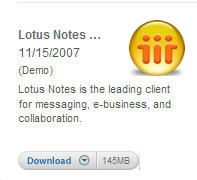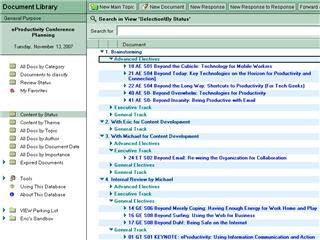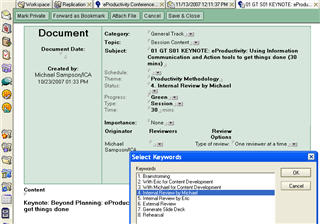Michael Sampson Skyped me with another of his daily reasons for why I should buy a Mac.

Apple's apparently listed Lotus Notes as a
featured download. The link is not for Notes R8, but this is exciting nonetheless. I've ranted about the lack of visibility of Notes for end-users. This is a step in the right direction. No idea if this is an Apple, IBM, or user initiated activity but it's exciting all the same. I've not tested the link yet but I hope that IBM's provided a reviewer's guide for the Mac. So often the power of Notes is not realized until someone explains or demonstrates how key features and concepts work. Notes is unique in so many ways that much of the power is often missed without a tour. Fortunately, we are seeing many good video tours on YouTube. Perhaps someone will post one for the Mac.
Continue Reading "Good on you, Apple, for Lotus Notes featured download" »
Michael Sampson and I are busy working on the session planning for our upcoming
eProductivity Conference. There remains much to complete, but we are supported by a wonderful group of advisors and great technology. I thought I wold take a quick break during lunch to share how we are using Lotus Notes to collaborate synchronously and asynchronously, across the Pacific.

Michael and I are using a Lotus Notes document library that we have customized to allow us to track all of the session planning and content for the 36 sessions for the eProductivity conference. We've added some
very basic workflow functionality. This allows us to flag any document as being in one of eight states:

This allows us to work together on content, synchronously and asynchronously - even though we are on opposite sides of the Pacific!
As we work on content I update a field in the document to change the document state to any of the above. In the background, as I work, these changes are replicated from my Windows laptop or Tablet PC in California to my primary server in Arizona and from there to Michael's Tablet PC or Mac, in New Zealand. It does not matter who's on-line, when, or what platform we choose to use. (Michael and I have a few quiet preferences about PC or Mac) After replication, each of us will see the documents that require our attention, edit and comment and flag them for review and the cycle continues back across the Pacific.
Think of it as digital volleyball.
Thanks to Lotus Notes replication, we are able to simultaneously manage hundreds of documents in various stages of completion.
Add to this, our use of MindManager and other productivity tools and we've got a neat system for information sharing and collaboration across the miles.
For me, a powerful aspect of this approach is not only the ability to compress work into a small amount of time, but the ability to break our focus down to very next actions. Between my family, graduate studies, client work, eProductivity Beta, and preparation for this conference, about the best I can do is keep my head down and focus on the simple next actions, the things I can do in one setting.
I'm grateful to have Michael's expertise as the eProductivity conference organizer. I can't imagine doing this without his help and without a cool set of tools to make distributed work easy.
Lunch is over. Time to get back to work.
I don't think so, but that's what I was told when I visited more than one booth of vendors of KM search technology at This week's
KM World conference in San Jose. (
Steve Barth and I presented a workshop on
Knowledge Worker Productivity at the conference.)
I had stopped by to ask if their search technology could crawl a Notes/Domino database. At which point I was told that the company saw no value in creating an add-on for a dead product. "IBM isn't even here at KMWorld, look around - do you see them anywhere?" I didn't. (Unless they were hidden behind the Microsoft Search booth.) I also did not see them in the list of exhibitors.
I did check the conference guide to find that IBM was listed as a sponsor of the taxonomy bootcamp. OK, that's a start. I also noticed that a presenter was doing a demo of an IBM search tool in his session. I realize that this was not a huge conference, but there are key decision makers here. Some that use Notes may be wondering to themselves if Notes is a dead product, while others, unaware of the power of Notes, will continue to be... unaware.
During this week at the KMWorld conference I've met many people that tell me they are using Lotus Notes successfully as their collaboration and knowledge management platform.
I heard this same comment more than once: "... people at the conference are all excited about product X or that new tool or "Tool 2.0", but our organization's had [most of] these capabilities with Lotus Notes for years...."
Of course, I did meet another speaker at the banquet who asked me if Lotus Notes was still being sold and supported. He was shocked when I told him that the last IBM # of Notes users I was aware of was 140 million Notes users. (Even if I'm off by a few tens of millions of users, that's nothing to sneeze at.)
So, what's the problem? Why are there so many decision makers that attended Enterprise 2.0 and KMWorld 2007 (and many other conferences I frequent) unaware of the power of Notes?
It's clearly not a technology problem. Many of the knowledge management professionals from the larger established companies were pleased to tell me about their Lotus Notes/Domino deployments. Many raved about Notes and more than one used my favorite expression about Notes:
"We're not getting rid of Notes in our organization; you'll have to pry Notes from our cold dead hands..."
I have many clients and I even know of several collaboration analysts who feel the same way.
Continue Reading ""Lotus Notes/Domino is a dead product"" »
 Apple's apparently listed Lotus Notes as a featured download. The link is not for Notes R8, but this is exciting nonetheless. I've ranted about the lack of visibility of Notes for end-users. This is a step in the right direction. No idea if this is an Apple, IBM, or user initiated activity but it's exciting all the same. I've not tested the link yet but I hope that IBM's provided a reviewer's guide for the Mac. So often the power of Notes is not realized until someone explains or demonstrates how key features and concepts work. Notes is unique in so many ways that much of the power is often missed without a tour. Fortunately, we are seeing many good video tours on YouTube. Perhaps someone will post one for the Mac.
Apple's apparently listed Lotus Notes as a featured download. The link is not for Notes R8, but this is exciting nonetheless. I've ranted about the lack of visibility of Notes for end-users. This is a step in the right direction. No idea if this is an Apple, IBM, or user initiated activity but it's exciting all the same. I've not tested the link yet but I hope that IBM's provided a reviewer's guide for the Mac. So often the power of Notes is not realized until someone explains or demonstrates how key features and concepts work. Notes is unique in so many ways that much of the power is often missed without a tour. Fortunately, we are seeing many good video tours on YouTube. Perhaps someone will post one for the Mac. 







